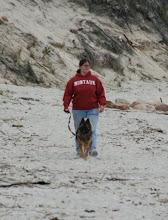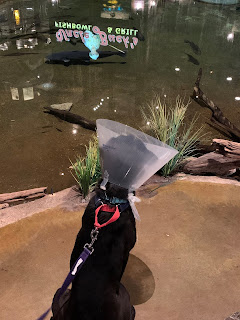Back out of all this now too much for us,
Back in a time made simple by the loss
Of detail, burned, dissolved, and broken off
Like graveyard marble sculpture in the weather,
There is a house that is no more a house
Upon a farm that is no mare a farm
And in a town that is no more a town.
The road there, if you'll let a guide direct you
Who only has at heart your getting lost,
May seem as if it should have been a quarry-
Great monolithic knees the former town
Long since gave up pretense of keeping covered.
-Robert Frost Directive
I don't remember anymore where the idea came from... I think I heard something on NPR that made me think about people relying on GPS and not knowing anymore how to read/use maps. So tangentially related to that idea I thought of going on a road trip where I had to take at least three highways and travel about two hours each time to end up... somewhere. Then once there I could look up what was in the area to explore. It would make me explore or learn about some place to which I never would have thought of going.
Thursday a co-worker asked what we were doing this weekend and we said nothing because we were dog sitting my Mom's dog. He was surprised and responded that we are always going places. So after leaving the bar, when all the best decisions are made, we decided to try out this road trip idea. We already would have Gypsy Rover so we needed dog friendly locations anyway why would one more dog change things.

One of the greatest things about Nashville is the amount of large interstate highways that circle it. We have so many starting points. This trip we started out by traveling south on I-65 towards Alabama. That would at least get us a good distance to start with. At the Alabama border we stopped to stretch and walk the dogs and see the Saturn 1B rocket that greets visitors to "Sweet Home Alabama." I've already known about this for awhile and every time I pass by I stop and check it out because it is awesome. The rocket was developed in Huntsville, Alabama and 9 of the 12 rockets were used to support the Apollo and other missions.
As we approached exit 328 I saw a sign that it was Jesse Owens Memorial Parkway. Since we were close to two hours I asked Meg if she wanted to switch highways and she agreed. So we exited and turned right to travel west on the Jesse Owens Memorial Highway, Highway 36, which took us through the town of Hartselle, self titled "The City of Southern Hospitality." We drove through their downtown area which definitely looks like a great spot to walk around and enjoy the different small businesses that lined the road. It is the second largest city in Morgan county and dates its founding back to 1870 when the citizens moved a half mile to its current location so the Alabama Railroad could put a stop there. The town became official in 1873 when a post office was opened and the town was named for George Hartselle, one of the owners of the railroad.
As I was trying to look up why it is called the "City of Southern Hospitality" I discovered that the town was the location of an infamous and still unsolved bank robbery. On the morning of March 15th (beware the Ides of March), 1926 possibly as many as 15 individuals robbed the bank of over $15,000 in gold and deposits. It was early in the morning when the robbers lined the wall with explosives and cut the town telephone lines to prevent people from calling for help. Several townspeople were taken hostage and one, a local dentist named Dr J.D. Johnston was injured. The whole event took over three hours and, despite the hard work of several different agencies, the robbery was never solved.
Now for the most part the point of the trip is getting to a new destination so I wanted to keep random stops to a minimum but since we were on the Jesse Owens Memorial Highway I decided to stop at the Jesse Owens Museum and Memorial. James Cleveland "Jesse" Owens was born in Alabama on September 12, 1913, and passed away in Arizona March 31, 1980. As a teenager he began to be noticed for his remarkable abilities in Track and Field; after high school he attended Ohio State University. In 1935 at Ann Arbor Michigan at the Big Ten Championships Owens achieved a feat that has been described by sports reporters as "the greatest 45 minutes ever in sports."
At 3:15 Jesse ran the 100 yard dash in 9.4 seconds to tie the world record.
At 3:25 in the long jump Jesse leaped 26-8 1/4 feet setting a world record that lasted for 25 years.
At 3:34 He ran the 220 yard dash in 20.3 seconds setting a new record.
At 4:00 Jesse ran the 220 low hurdles in 22.6 seconds breaking 23 seconds for the first time in the event.
A year later Jesse traveled to Germany to compete in the Olympics in Track and Field. He won the gold in long jump with a final jump of 26-5 1/2 feet, set an Olympic record for the 200 meter dash in 20.7 seconds, was part of the 4x100 relay team that set a world record of 39.8 seconds that would stand for 20 years, and his fourth gold medal was from the 100 meter dash.
Jesse's feat at those Olympics is one of the greatest moments in sports because it is one of the times when a sporting event was more than just that event or game. At that moment in Germany with tension and the Nazi party rising Jesse's victories were victories against the Nazi ideal. Jesse's victories and story also highlighted the need for the Civil Rights movement in America. Jesse had had to work his way through college because as an African American he wasn't eligible for many of the scholarships that were offered. He came home to a parade honoring the US Olympic team's success and had to take a freight elevator at the back of the Waldorf because he wasn't allowed in the front door. In an interview Jesse said:
"When I came back to my native country, after all the stories about Hitler, I couldn't ride in the front of the bus, ... I had to go to the back door, I couldn't live where I wanted. I wasn't invited to shake hands with Hitler, but I wasn't invited to the White House to shake hands with the President, either."
In 1976 President Ford awarded Jesse the Medal of Freedom and posthumously in 1990 President Bush awarded Jesse the Congressional Medal of Honor calling his victory in 1936, "an unrivaled athletic triumph, but more than that, a triumph for all humanity."
Beneath the statue was a plaque that read:
"Jesse Owens
Olympic Champion
1936
Athlete and humanitarian whose inspiration personifies the spirit and promise of America."
We left the memorial and drove past the Oakville Indian Mound a testament to over 14,000 years of human life before returning to 36 west.
After we had been on 36 west for a little over 32 minutes the road ended, something I hadn't thought too much about. So we turned on to 33 South and considered 36 as yielding its remaining time to the new highway. We drove through the beautiful Bankhead National Forest. Technically 33 South yielded its last remaining time to 19th street in Jasper, Alabama, before we switched to 5 South, our third highway.
5 South got a little dicey but somehow we stayed on it as it joined with 11 South, 20 West, and 59 South. And then each of those highways separated and we were alone on 5 South. And that is how we got to Brent, Alabama.
Brent was founded in 1898 along the Gulf, Mobile, and Ohio Railroad line and was named for a Bibb county surveyor Brent H. Armstrong. On May 27th, 1973, a series of tornados wrecked havoc across the South including one F4 which destroyed most of the town. That tornado was on the ground for 139 miles making it the longest track by a tornado in Alabama.

The trip was successful in my mind. I never would have traveled to Brent, Alabama, if not for this. At most it would have become a familiar name if I saw it enough times on a highway sign. I never would have known about the record setting tornado or the story of resilience of a town coming together to heal and rebuild. We also might have never taken a trip on the Jesse Owens Memorial Highway or know how close we were to his Memorial and Museum, and we never would have taken the beautiful scenic drive through the Bankhead National Forest. This is as close as I can piece together the actual path of our trip.
Now that we had finished the trip and discovered the history of Brent I began to search out other attractions/breweries/restaurants in the area. I used the website Bring Fido to try and find some dog friendly locations and I found three: Black Warrior Brewing, Druid City Brewing, and Wilhagans restaurant.
First we went to Black Warrior Brewing to try some of their brews. The brewery is so dog friendly that they had a water bowl for dogs and they make their own dog treats using their spent grain from the brewing process. We each bought a flight to try several of their beers and pick a growler to take home and a bag of treats for the pups. Here is my review on Yelp.

After leaving Black Warrior we went looking for something to eat and stopped at Wilhagans for their broccoli cheese bites which were amazing (disclaimer we ate some before I took the picture) and really good burgers. We took the food with us to Druid City Brewing to eat. Meg ate her burger first while I held on to the dogs and she told me the burger was delicious and very flavorful. When we switched and I bit into the burger I exclaimed that she was right the burger was delicious and several people at Druid City saw the burger and asked us where it was from so hopefully they get some more business for it.
Druid City brewing is a small brewery and they had trivia starting so we ate quickly to make more room. Meg had a porter and I had their ale because I asked what was most popular. The beers were good and the place had a neat atmosphere including a record player behind the bar and records from which to choose.
Finally we had one last stop before we headed home and that was a McDonalds in Northport, AL. Now that may seem like a long way to go for McDonalds but Meg wanted to try the new shamrock Oreo McFlurry, which was delicious, and Ronal Reagan once ate at that McDonalds.
Not bad for a random road trip when we didn't know where we were going.







































